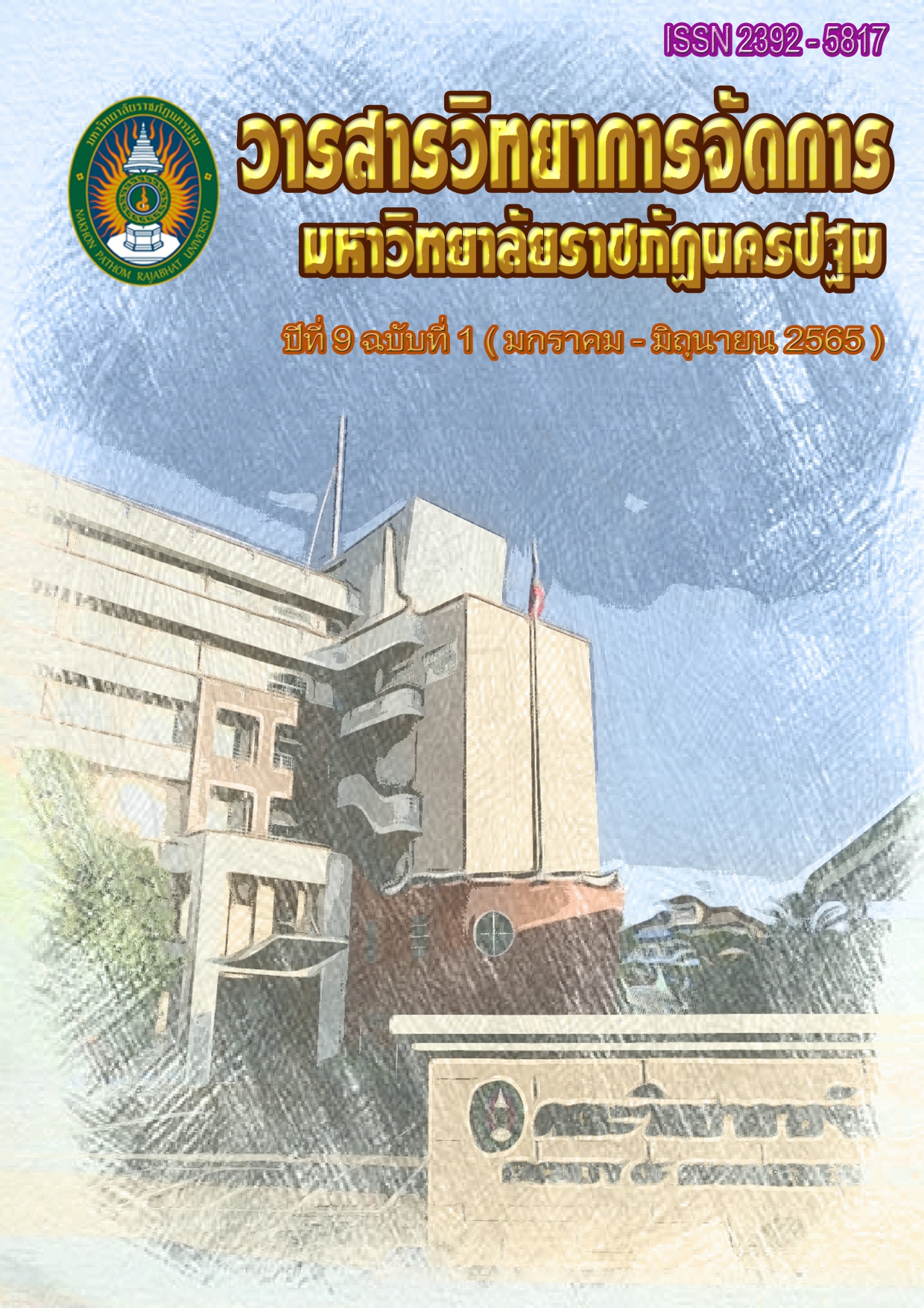Conditions for the Success of the Social Enterprise Operation of Community in Suphanburi Province.
Main Article Content
Abstract
This research purpose for 1) study the social enterprise operation process of community enterprises in Suphanburi province. 2) study the success conditions in social enterprise operation of community enterprises in Suphanburi province. This research uses a qualitative research methodology. The main informants are : chairman and members of Ka Sed In See Thung Thong Yung Yuen and Ruen Thai Ban Bang Mae Mai Homestay the community enterprise group. Including government officials from Suphanburi provincial agriculture and cooperatives office and officials from Pra Cha Rat Rak Sa Mak Kee company, Suphanburi province. A total of 10 keys contributors. The research instrument was a semi-structured interview and use document analysis qualitative data analysis by creating foundation theory and content analysis.
The results of the research were as follows: 1. Operation of social enterprises of community enterprises in Suphanburi province has the following processes: 1) Creating products for social goals by relying on costs in the community to create products and services. 2) To build financial stability by establishing a fund as reserve funds for group management. 3) Environmentally friendly operations by working in every step of the group, taking into account the environment. 4) Returning returns to community and society by using labor of members and products of the group. 5) Building knowledge from the community, through the form of transmission from generation to generation through activities. 2. The conditions for the success of social enterprise operations of community enterprises in Suphanburi province consist of 1) Entrepreneurial leadership by planning and managing to lead the group to the goals that are set. 2) Product development to be creative by creating differentiation and diversity for consumers. 3) good management by operating according to the plan with transparency. 4) The participation of local communities, where people in the community support and cooperate with group actions or activities. 5) Cooperation from the network by providing advice, knowledge, including capital for business operations. 6) Success from business operations by solving problems that arise in the community and the group is stable. This research suggests that should have a policy to support promote creativity of products or services from agency to be of interest to consumers, which help solve the income problem of the people in the community. This process leads to the formation of a social enterprise group in the community.
Article history : Received 4 October 2021
Revised 28 December 2021
Accepted 9 January 2022
SIMILARITY INDEX = 2.53 %
Article Details

This work is licensed under a Creative Commons Attribution-NonCommercial-NoDerivatives 4.0 International License.
The views and opinions of the article appearing in this journal are those of the author. It is not considered a view and responsibility of the editorial staff.
References
กนกพร ฉิมพลี. (2555). รูปแบบการจัดการความรู้ภูมิปัญญาท้องถิ่นด้านหัตถกรรมเครื่องจักสาน : วิสาหกิจชุมชนจังหวัดนครราชสีมา. วิทยานิพนธ์ปริญญาดุษฎีบัณฑิต, สถาบันบัณฑิตพัฒนบริหารศาสตร์.
เกรียงไกร ทรัพย์แสนมา และสิริ ลภัสลดา ปันสาน. (2562). รูปแบบการพัฒนาสินค้าเกษตรของบริษัทประชารัฐรักสามัคคีวิสาหกิจเพื่อสังคม (ประเทศไทย) จำกัด. วารสารบริหารการปกครองและนวัตกรรมท้องถิ่น, 3 (2), 67 - 75.
ชมภูนุท จั่นนุ้ย และพินิจ ลาภธนานนท์. (2562). ความสำเร็จของวิสาหกิจชุมชนบนพื้นฐานความอยู่รอดและพอเพียง. วารสารศิลปะศาสตร์ปริทัศน์, 14 (1), 67 – 78.
ณัฐภัทร สุนทรมีเสถียร. (2552). ทุนทางสังคมกับการจัดการวิสาหกิจชุมชน : กรณีศึกษากลุ่มวิสาหกิจชุมชน ตำบลบางสน หมู่บ้านหัวนอน ตำบลบางสน อำเภอปะทิว จังหวัดชุมพร. วิทยานิพนธ์สังคมสงเคราะห์ศาสตรมหาบัณฑิต มหาวิทยาลัยธรรมศาสตร์.
ทิชากร เกสรบัว. (2556). การพัฒนาศักยภาพกลุ่มสินค้าหนึ่งตำบลหนึ่งผลิตภัณฑ์สู่วิสาหกิจขนาดกลางและขนาดย่อม กรณีศึกษา กลุ่มวิสาหกิจชุมชนแปรรูปอาหารจากกล้วย. วารสารการจัดการสมัยใหม่, 11 (2), 74 – 86.
ธงชัย พาบุ. (2552). การจัดการความรู้ธุรกิจชุมชนสุดยอดหนึ่งตำบลหนึ่งผลิตภัณฑ์. วิทยานิพนธ์ปริญญาปรัชญาดุษฎีบัณฑิตสาขา วิชาสารสนเทศศึกษา บัณฑิตวิทยาลัย มหาวิทยาลัยขอนแก่น..
ธิเดช จันทราเดช. (2546). บทบาทของธุรกิจชุมชนในการแก้ปัญหาความยากจนในชนบทในภาคเหนือของประเทศไทย. [ออนไลน์]. สืบค้นเมื่อ 28 มกราคม 2563 จาก http://dric.nrct.go.th/search/showfulltext/1/135637
นงลักษณ์ ทองศรี. (2559). รูปแบบการจัดการของกลุ่มวิสาหกิจชุมชนผลิตภัณฑ์ผ้าไหม จังหวัดบุรีรัมย์. [ออนไลน์]. สืบค้นเมื่อ 28 มกราคม 2563 จาก http://dspace.bru.ac.th/xmlui/handle/123456789/534
นพพร จันทรนำชู. (2563). พัฒนศึกษา : ความหลากหลายของกระบวนทัศน์เพื่อการพัฒนาที่ยั่งยืน. กรุงเทพฯ : วัฒนาพานิช.
ประพิน นุชเปี่ยม ติญทรรศน์ ประทีปพรณรงค์ และบงกช เจนจรัสสกุล. (2561). วิสาหกิจเพื่อสังคมในประเทศไทย : ข้อสังเกตบางประการต่อร่างพระราชบัญญัติส่งเสริมวิสาหกิจเพื่อสังคม, สำนักงานผู้ตรวจการแผ่นดิน, 11 (1), 109 -141.
ปรานี ตปนียวรวงศ์. (2560). วิเคราะห์ปัจจัยความมั่นคงทางการเงินของสหกรณ์ออมทรัพย์ในเขตพื้นที่ภาคเหนือของไทย, วารสารการจัดการธุรกิจ มหาวิทยาลัยบูรพา, 6 (2), 105 -118.
พัชรี ฉลาดธัญญกิจ. (2558). การพัฒนารูปแบบการจัดการแบบมีส่วนร่วมของผู้ผลิตผู้ทอฝ้ายที่เป็นมิตรกับสิ่งแวดล้อมในภาคเหนือตอนล่างของประเทศไทย. วารสารวิชาการมหาวิทยาลัยราชภัฏพระนคร, 6 (2), 246 – 255.
พิทักษ์พงศ์ กิตติโสภณ. (2550). การเสริมสร้างความเข้มแข็งของชุมชนภายใต้พระราชบัญญัติส่งเสริมวิสาหกิจชุมชน พ.ศ.2548 : ศึกษากรณีกลุ่มผู้ผลิตสินค้า. วิทยานิพนธ์รัฐประศาสนศาสตรมหาบัณฑิต มหาวิทยาลัยนเรศวร.
วรรณิดา สารีคำ และจันทิมา พรหมเกษ. (2562). ศักยภาพการจัดการห่วงโซ่อุปทานที่เป็นมิตรกับสิ่งแวดล้อมที่มีผลต่อการดำเนินงานของผู้ประกอบการวิสาหกิจชุมชนแปรรูปผลิตผลทางการเกษตรในจังหวัดสกลนคร. วารสารวิชาการ Veridian E-Journal, 12 (5), 1482 – 1500.
วรัทยา ธรรมกิตติภพ, พีรพงศ์ ทิพนาค และวิทยา เบ็ญจาธิกุล. (2558). กระบวนการเรียนรู้แบบมีส่วนร่วมในการจัดการธุรกิจชุมชนเพื่อสร้างความเข้มแข็งอย่างยั่งยืนของชุมชน.วารสารวิชาการมหาวิทยาลัยกรุงเทพธนบุรี, 4 (1), 200 -212.
วราภรณ์ ศรีบุญ. (2552). ปัจจัยที่มีผลต่อความสำเร็จในการดำเนินงานของผู้ประกอบการผลิตภัณฑ์ชุมชนและท้องถิ่น (OTOP) ในจังหวัดสงขลา. วิทยานิพนธ์ปริญญารัฐศาสตรมหาบัณฑิตมหาวิทยาลัยสงขลานครินทร์.
วารุณี ชินวินิจกุล. (2549). กระบวนการเรียนรู้ของชุมชนตามแนวคิดเศรษฐกิจพอเพียง : กรณีศึกษาชุมชนไม้เรียง อำเภอฉวาง จังหวัดนครศรีธรรมราช. [ออนไลน์]. สืบค้นเมื่อ 28 มกราคม 2563 จาก http://dric.nrct.go.th/index.php/Search/SearchDetail/177714
ศักดิ์ดา ศิริภัทรโสภณ. (2558). การศึกษากรอบแนวคิดเพื่อการพัฒนาวิสาหกิจเพื่อสังคมในประเทศไทย. วารสารสมาคมนักวิจัย, 20 (2), 30-45.
ศิรวิชญ์ สุประดิษฐ์. (2562). รูปแบบการดำเนินวิสาหกิจเพื่อสังคมของการท่องเที่ยวโดยชุมชนของวิสาหกิจชุมชนท่องเที่ยวบ้านแหลมสัก ตำบลแหลมสัก อำเภออ่าวลึก จังหวัดกระบี่. วารสารวิชาการ Veridian E-Journal, 12 (5), 1571 – 1584.
สันติธร ภูริภักดี. (2561). การพัฒนาองค์ความรู้สำหรับสร้างมูลค่าเพิ่มผลิตภัณฑ์เพื่อเพิ่มขีดความสามารถทางการแข่งขันแก่ผู้ประกอบการหนึ่งตำบลหนึ่งผลิตภัณฑ์ (OTOP) ในเขตจังหวัดเพชรบุรี ประจวบคีรีขันธ์ สมุทรสงคราม และสมุทรสาคร. วารสารวิชาการ Veridian E-Journal, 11 (2), 2153 – 2168.
สิริ ลภัสลดา ปันสาน. (2562). รูปแบบการจัดการธุรกิจท่องเที่ยวโดยชุมชนของบริษัทประชารัฐรักสามัคคี วิสาหกิจเพื่อสังคม (ประเทศไทย) จำกัด. วารสาร มจร. สังคมศาสตรปริทรรศน์, 8 (3), 233 - 243.
สำนักงานคณะกรรมการพัฒนาการเศรษฐกิจและสังคมแห่งชาติ. (2560). สรุปสาระสำคัญแผนพัฒนาเศรษฐกิจและสังคมแห่งชาติ ฉบับที่ 12. [ออนไลน์]. สืบค้นเมื่อ 1 กุมภาพันธ์ 2563 จาก http://www.nesdb.go.th.
สำนักงานสร้างเสริมวิสาหกิจเพื่อสังคมแห่งชาติ.(2557). แผนแม่บท สร้างเสริมกิจการเพื่อสังคม พ.ศ.2553-2557. [ออนไลน์]. สืบค้นเมื่อ 1 กุมภาพันธ์ 2563 จาก http://www.tseo.or.th/sites/default/files/se_masterplan.pdf
อนุชา ม่วงใหญ่. (2559). แนวทางการพัฒนาเพื่อเสริมสร้างศักยภาพชุมชนและท้องถิ่น “ ในศตวรรษที่ 21”. วารสารวิชาการมหาวิทยาลัยอีสเทิร์นเอเชีย, 6 (3), 12 – 25.
Brodziski, Gloria. and Village C. (2012). Economic and community development through an industrial park. Retrieved Febuary 2, 2020, from http://www.uwex.edu/ces/cced/economies/northernedge/bestpractices/marathon.cfm.
Choi, S.H. and H.H. Cheung. (2017). Multi – material virtual prototyping for product development and biomedical engineering. Computers in Industry. 58 (5), 438 – 452.
Corbin, J., and Strauss, A. (2008). Basics of qualitative research. (3rd ed.). Los Angeles, CA: SAGE.
Elkington, J. (1997). Cannibals with Forks: The Triple Bottom Line of Twenty - First Century Business. Capstone, LN: Oxford.
Emerson, J. (2003). The blended value proposition: Integrating social and financial returns. California Management Review, 45(4), 35-51.
Watson, J. (2007). Modeling the relationship between networking and firm performance. Journal of Business Venturing, 22 (6), 852 – 874.

